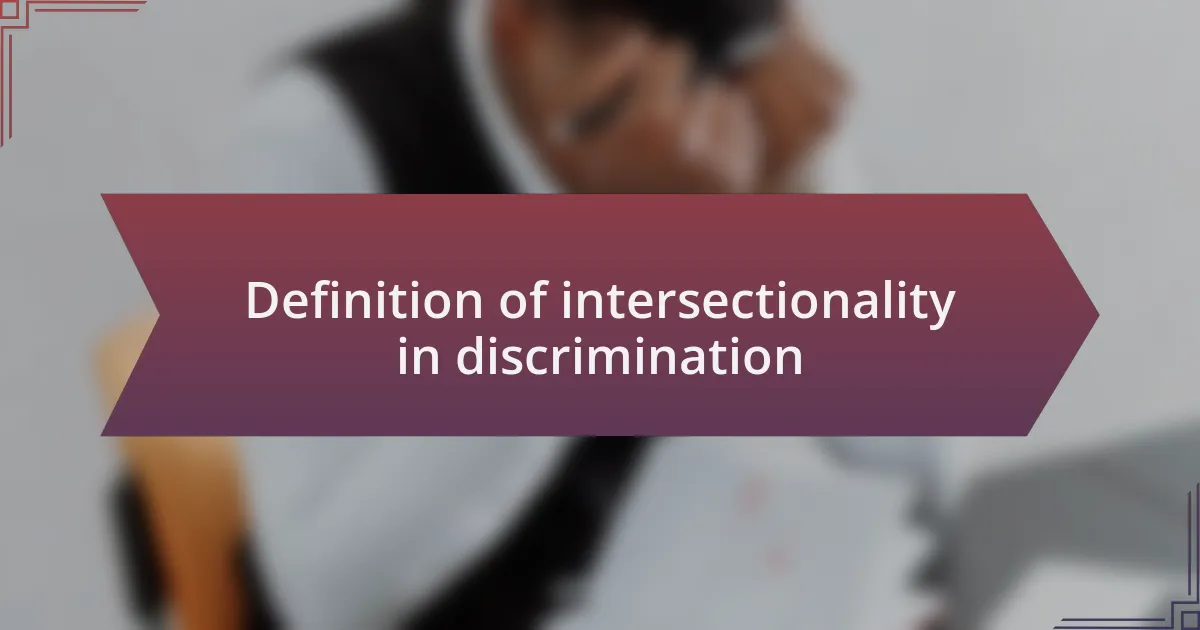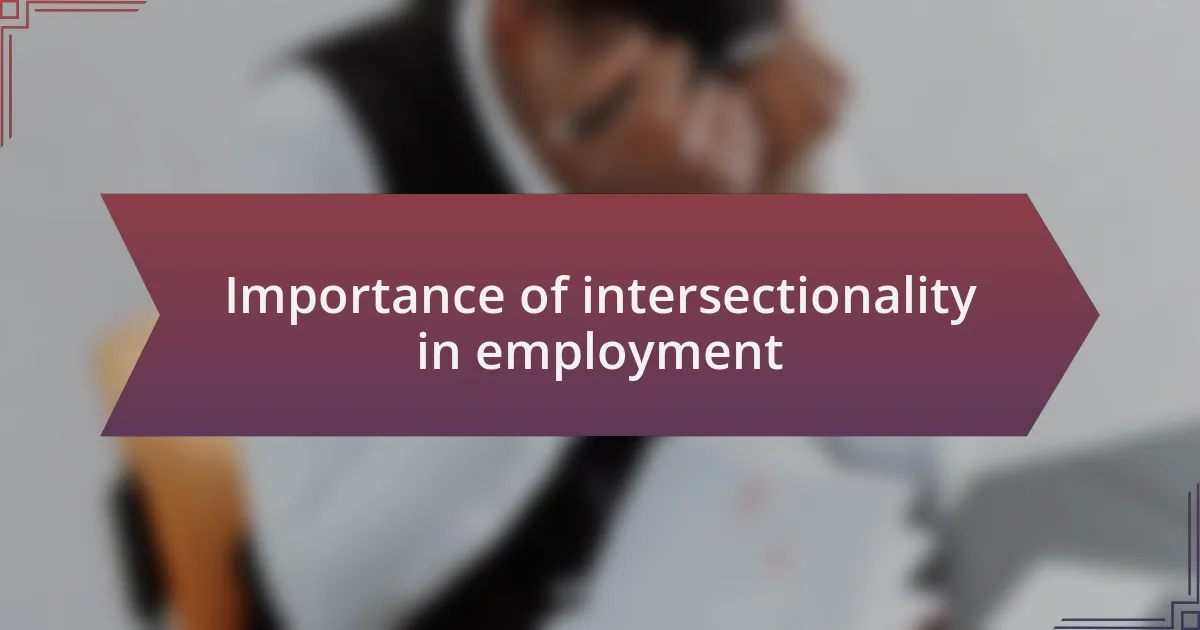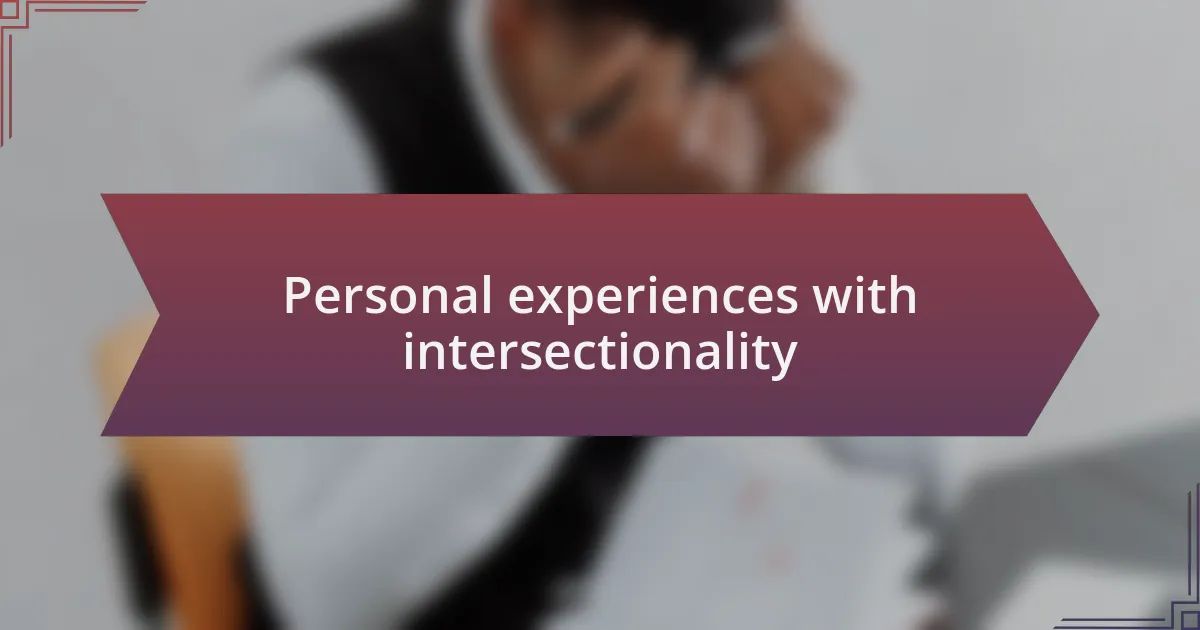Key takeaways:
- Intersectionality highlights the interconnected nature of various social identities, emphasizing the need for inclusive workplace policies that address overlapping disadvantages.
- Recent trends in employment law focus on diversity, equity, and inclusion, with an emphasis on unconscious bias training and mental health support for employees.
- Personal experiences illustrate how intersectional identities can influence professional perceptions and opportunities, underscoring the importance of empathy and inclusivity in hiring practices.
- Effective strategies to address intersectionality include blind recruitment processes, intersectional awareness training, and mentorship programs that reflect diverse identities.

Definition of intersectionality in discrimination
Intersectionality, in the context of discrimination, refers to the interconnected nature of social categorizations such as race, gender, and class, which can lead to overlapping systems of disadvantage. I remember a colleague sharing her experience of being overlooked for promotion not just because she was a woman, but also due to her ethnic background. This example highlights how individuals can face compounded discrimination based on multiple identities.
When I think about intersectionality, I often ask myself: how do we address these overlapping identities in workplace policies? It’s crucial, especially when considering that a single-axis approach to discrimination falls short. Many people experience unfair treatment that can’t be fully understood if we isolate one aspect of their identity; for instance, a Black woman may face different challenges than a Black man or a white woman.
Understanding intersectionality means recognizing that everyone’s experience is unique and multifaceted. In my own experience, I’ve seen how employees with intersecting identities might feel invisible or unheard. This realization deepens the need for inclusive practices in workplaces, encouraging a more profound conversation about diversity that goes beyond basic categories.

Importance of intersectionality in employment
Acknowledging intersectionality in employment is vital for fostering an inclusive work environment. I recall a time when a friend, who identifies as both + and a person of color, faced barriers that seemed unrecognizable to many of her colleagues. This made me reflect on how crucial it is for employers to understand these layered identities to create supportive policies and practices that truly address the needs of all employees.
When we overlook the complexities of intersectionality, we risk perpetuating disparities in recruitment, retention, and promotion. I often find myself wondering: how can we ensure our hiring processes are fair if we don’t consider the varied backgrounds and experiences of applicants? For example, an individual from a marginalized community might have to navigate both professional and cultural biases, which can significantly impact their career trajectory.
Moreover, intersectionality sheds light on the unique challenges that individuals face in the workplace. I remember talking to a mentor who felt the weight of dual expectations as a woman of color in a male-dominated industry. Her stories reinforced for me that intersectionality isn’t just an academic concept; it’s a lived reality that demands our attention to ensure equity and justice in employment decisions.

Current trends in employment law
One notable trend in employment law is the increased focus on diversity, equity, and inclusion (DEI) initiatives. I recently spoke with a HR manager who emphasized that companies are now prioritizing training programs to address unconscious bias in hiring. This shift is not merely a legal compliance strategy; it’s about creating workplaces where everyone feels valued. How can we expect innovation and growth if we inadvertently silence diverse perspectives?
Another emerging trend is the growing recognition of mental health as a critical aspect of employee well-being. In my experience, discussions around workplace mental health are becoming more prevalent, with companies implementing policies that support mental wellness. I remember a colleague who benefited immensely from a flexible work schedule during a challenging time. This made me realize that when organizations actively recognize mental health, they foster a more engaged and productive workforce.
Furthermore, remote work has challenged traditional employment practices, leading to a reevaluation of workplace equality. I’ve noticed that numerous companies are now analyzing their policies to ensure fair treatment for remote employees, but it raises an interesting question: how do we guarantee that remote work doesn’t exacerbate existing inequalities? This ongoing dialogue around remote work is crucial as it highlights the intersection of technology, equity, and job opportunities.

Personal experiences with intersectionality
When I reflect on my own experiences, I’ve often felt the impact of intersectionality in ways that surprise me. For instance, I remember attending a networking event where the majority of attendees came from a similar demographic background, leaving me feeling both isolated and underestimated as a person of color and a woman. This experience underscored how my identity influenced how others perceived my professional capabilities and made me ponder: how many voices are silenced in such environments because they don’t fit the mold?
In a different scenario, I encountered an unexpected bias while applying for leadership positions. Despite having a strong resume, I sensed that my age played a role in how hiring managers viewed my potential. It was disheartening to realize that societal expectations could limit opportunities based on age and gender, leading me to question not just my own abilities but also the broader systems that dictate who gets to lead. Empathy in these moments only reinforced my belief in the necessity of intersectional approaches in hiring practices.
These experiences have compelled me to advocate for more inclusive atmospheres in the workplace. Each conversation I’ve had about intersectionality has revealed layers of bias that often go unrecognized — whether related to race, gender, or socioeconomic background. I find myself constantly asking: how can we create an environment where varied experiences enhance, rather than hinder, collaboration and innovation?

Strategies for addressing intersectionality
Addressing intersectionality requires intentional strategies that foster inclusivity at all levels. I recall a time when my team introduced blind recruitment processes. This shift allowed candidates to be assessed based solely on their skills and qualifications, significantly reducing biases related to identity markers. It made me think, how many talented individuals might we have overlooked due to unconscious biases?
We also implemented regular training workshops focused on intersectional awareness, which I found incredibly valuable. These sessions encouraged open dialogues, allowing team members to share their diverse experiences and how they intersect. Adjusting our workplace culture in this way sparked discussions that I never anticipated, prompting me to ask: are we really understanding the full spectrum of our colleagues’ experiences, or are we just scratching the surface?
Additionally, establishing mentorship programs that prioritize underrepresented voices can create pathways for growth. In my own career, a mentor who recognized the nuances of my identity played a crucial role in helping me navigate challenges. This experience has made me wonder if other organizations would benefit from similar initiatives, ensuring that mentorship reflects the complexities of intersectionality. Wouldn’t it enrich our workplaces if every employee could connect with someone who truly understands their multifaceted identity?